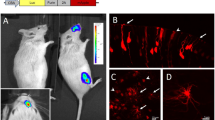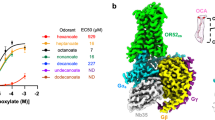Abstract
A fundamental question in olfaction is which odorant receptors (ORs) are activated by a given odorant. A major roadblock to investigating odorant–OR relationships in mammals has been the inability to express ORs in heterologous cells suitable for screening active ligands for ORs. The discovery of the receptor-transporting protein family has facilitated the effective cell-surface expression of ORs in heterologous cells. The establishment of a robust heterologous expression system for mammalian ORs facilitates the high-throughput 'deorphanization' of these receptors by matching them to their cognate ligands. This protocol details the method used for evaluating the cell-surface expression and measuring the functional activation of ORs of transiently expressed mammalian ORs in HEK293T cells. The stages of OR cell-surface expression include cell culture preparation, transfer of cells, transfection, immunocytochemistry or flow cytometry, odorant stimulation and luciferase assay. This protocol can be completed in a period of 3 d from the transfer of cells to cell-surface expression detection and/or measurement of functional activation.
This is a preview of subscription content, access via your institution
Access options
Subscribe to this journal
Receive 12 print issues and online access
$259.00 per year
only $21.58 per issue
Buy this article
- Purchase on Springer Link
- Instant access to full article PDF
Prices may be subject to local taxes which are calculated during checkout






Similar content being viewed by others
References
Barnea, G. et al. Odorant receptors on axon termini in the brain. Science 304, 1468 (2004).
Strotmann, J., Levai, O., Fleischer, J., Schwarzenbacher, K. & Breer, H. Olfactory receptor proteins in axonal processes of chemosensory neurons. J. Neurosci. 24, 7754–7761 (2004).
Niimura, Y. & Nei, M. Extensive gains and losses of olfactory receptor genes in mammalian evolution. PLoS ONE 2, e708 (2007).
Niimura, Y. & Nei, M. Evolutionary changes of the number of olfactory receptor genes in the human and mouse lineages. Gene 346, 23–28 (2005).
Godfrey, P.A., Malnic, B. & Buck, L.B. The mouse olfactory receptor gene family. Proc. Natl. Acad. Sci. USA 101, 2156–2161 (2004).
Malnic, B., Godfrey, P.A. & Buck, L.B. The human olfactory receptor gene family. Proc. Natl. Acad. Sci. USA 101, 2584–2589 (2004).
Zhang, X. & Firestein, S. The olfactory receptor gene superfamily of the mouse. Nat. Neurosci. 5, 124–133 (2002).
Glusman, G., Yanai, I., Rubin, I. & Lancet, D. The complete human olfactory subgenome. Genome Res. 11, 685–702 (2001).
Young, J.M. et al. Different evolutionary processes shaped the mouse and human olfactory receptor gene families. Hum. Mol. Genet. 11, 535–546 (2002).
Amoore, J.E., Johnston, J.W. Jr. & Rubin, M. The Sterochemical theory of odor. Sci. Am. 210, 42–49 (1964).
Buck, L. & Axel, R. A novel multigene family may encode odorant receptors: a molecular basis for odor recognition. Cell 65, 175–187 (1991).
Tate, C.G. & Grisshammer, R. Heterologous expression of G-protein-coupled receptors. Trends Biotechnol. 14, 426–430 (1996).
Lu, M., Echeverri, F. & Moyer, B.D. Endoplasmic reticulum retention, degradation, and aggregation of olfactory G-protein coupled receptors. Traffic 4, 416–433 (2003).
McClintock, T.S. et al. Functional expression of olfactory-adrenergic receptor chimeras and intracellular retention of heterologously expressed olfactory receptors. Brain Res. Mol. Brain Res. 48, 270–278 (1997).
Gimelbrant, A.A., Haley, S.L. & McClintock, T.S. Olfactory receptor trafficking involves conserved regulatory steps. J. Biol. Chem. 276, 7285–7290 (2001).
Dwyer, N.D., Troemel, E.R., Sengupta, P. & Bargmann, C.I. Odorant receptor localization to olfactory cilia is mediated by ODR-4, a novel membrane-associated protein. Cell 93, 455–466 (1998).
Saito, H., Kubota, M., Roberts, R.W., Chi, Q. & Matsunami, H. RTP family members induce functional expression of mammalian odorant receptors. Cell 119, 679–691 (2004).
Zhuang, H. & Matsunami, H. Synergism of accessory factors in functional expression of mammalian odorant receptors. J. Biol. Chem. 282, 15284–15293 (2007).
Von Dannecker, L.E., Mercadante, A.F. & Malnic, B. Ric-8B, an olfactory putative GTP exchange factor, amplifies signal transduction through the olfactory-specific G-protein Galphaolf. J. Neurosci. 25, 3793–3800 (2005).
Von Dannecker, L.E., Mercadante, A.F. & Malnic, B. Ric-8B promotes functional expression of odorant receptors. Proc. Natl. Acad. Sci. USA 103, 9310–9314 (2006).
Keller, A., Zhuang, H., Chi, Q., Vosshall, L.B. & Matsunami, H. Genetic variation in a human odorant receptor alters odour perception. Nature 449, 468–472 (2007).
Katada, S., Nakagawa, T., Kataoka, H. & Touhara, K. Odorant response assays for a heterologously expressed olfactory receptor. Biochem. Biophys. Res. Commun. 305, 964–969 (2003).
Sands, W.A. & Palmer, T.M. Regulating gene transcription in response to cyclic AMP elevation. Cell Signal 20, 460–466 (2008).
Zhao, H. et al. Functional expression of a mammalian odorant receptor. Science 279, 237–242 (1998).
Touhara, K. et al. Functional identification and reconstitution of an odorant receptor in single olfactory neurons. Proc. Natl. Acad. Sci. USA 96, 4040–4045 (1999).
Krautwurst, D., Yau, K.W. & Reed, R.R. Identification of ligands for olfactory receptors by functional expression of a receptor library. Cell 95, 917–926 (1998).
Kajiya, K. et al. Molecular bases of odor discrimination: reconstitution of olfactory receptors that recognize overlapping sets of odorants. J. Neurosci. 21, 6018–6025 (2001).
Offermanns, S. & Simon, M.I. G alpha 15 and G alpha 16 couple a wide variety of receptors to phospholipase C. J. Biol. Chem. 270, 15175–15180 (1995).
Shirokova, E. et al. Identification of specific ligands for orphan olfactory receptors. G protein-dependent agonism and antagonism of odorants. J. Biol. Chem. 280, 11807–11815 (2005).
Chandrashekar, J. et al. T2Rs function as bitter taste receptors. Cell 100, 703–711 (2000).
Sambrook, J. & Russell, D.W. Molecular Cloning: A Laboratory Manual (Cold Spring Harbor Laboratory Press, Cold Spring Harbor, NY, 2001).
Harlow, E., Lane, D. & Cold Spring Harbor Laboratory Antibodies: a Laboratory Manual xiii, 726 p. (Cold Spring Harbor Laboratory, Cold Spring Harbor, NY, 1988).
Araki, I. & Nakamura, H. Engrailed defines the position of dorsal di-mesencephalic boundary by repressing diencephalic fate. Development 126, 5127–5135 (1999).
Laird, D.W. & Molday, R.S. Evidence against the role of rhodopsin in rod outer segment binding to RPE cells. Invest. Ophthalmol. Vis. Sci. 29, 419–428 (1988).
Osborn, M. & Weber, K. Immunofluorescence and immunocytochemical procedures with affinity purified antibodies: tubulin-containing structures. Methods Cell Biol. 24, 97–132 (1982).
Philpott, N.J. et al. The use of 7-amino actinomycin D in identifying apoptosis: simplicity of use and broad spectrum of application compared with other techniques. Blood 87, 2244–2251 (1996).
Acknowledgements
We thank A. Toyama for FACS data. This research was supported by grants to H.M. from the NIH and Human Frontier Science Program and to H.Z. from an NIH NRSA Predoctoral fellowship.
Author information
Authors and Affiliations
Corresponding authors
Rights and permissions
About this article
Cite this article
Zhuang, H., Matsunami, H. Evaluating cell-surface expression and measuring activation of mammalian odorant receptors in heterologous cells. Nat Protoc 3, 1402–1413 (2008). https://doi.org/10.1038/nprot.2008.120
Published:
Issue Date:
DOI: https://doi.org/10.1038/nprot.2008.120
This article is cited by
-
Dissecting the genetic landscape of GPCR signaling through phenotypic profiling in C. elegans
Nature Communications (2023)
-
Two entry tunnels in mouse TAAR9 suggest the possibility of multi-entry tunnels in olfactory receptors
Scientific Reports (2022)
-
The role of the odorant receptors in the formation of the sensory map
BMC Biology (2021)
-
Mixture interactions at mammalian olfactory receptors are dependent on the cellular environment
Scientific Reports (2021)
-
A novel bioassay for quantification of surface Cannabinoid receptor 1 expression
Scientific Reports (2020)
Comments
By submitting a comment you agree to abide by our Terms and Community Guidelines. If you find something abusive or that does not comply with our terms or guidelines please flag it as inappropriate.



